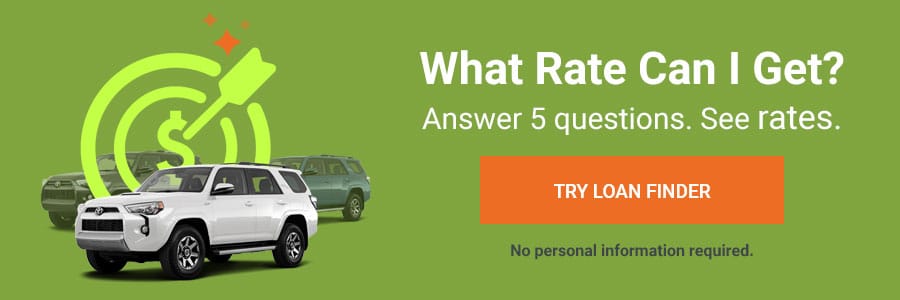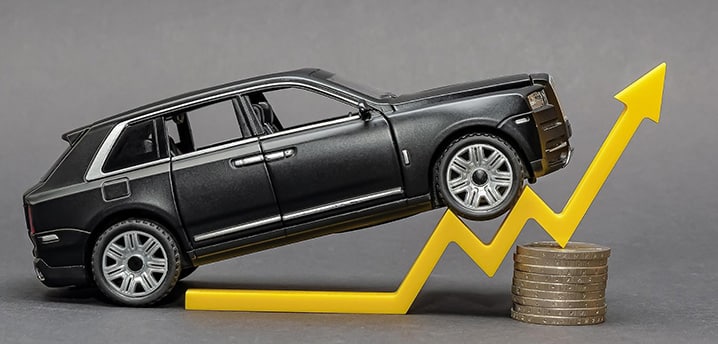Car prices have climbed to ridiculous heights. Will they stay high or return to normal?
Inflation is normal — life usually gets a little more expensive every year. It’s not supposed to be that noticeable though, let alone a catalyst for overhauling your lifestyle.
Just about everything seems to cost an arm and a leg these days. Rent. Gas. Chipotle.
Cars are no exception. But unlike a savory chicken burrito with extra guac, cars are necessities for most people. And if you need a new set of wheels, you’re likely discouraged by current car prices.
So, when will car prices drop? Can you realistically take the “wait and see” approach? Or will car prices stay in the clouds for years to come? While we don’t have a crystal ball for car prices, we can look at what history tells us and gauge expert guidance.
Are Car Prices High? History Says Yes
Yes, car prices are through the sunroof. Many Americans have shelled out thousands of dollars more than sticker prices.
In September, the average transaction price (ATP) for new vehicles was an account-draining $48,094, according to Kelley Blue Book data. While this was slightly down from the all-time high set in August ($48,240), the new-vehicle ATP exceeded the average sticker price or MSRP for the 16th consecutive month.
That alone gives you an idea of how elevated new car prices have been. But terms like “high” and “expensive” are relative. Especially since new cars are big purchases in general.
Question: How much higher are current vehicle prices compared to historical levels?
Answer: Exceedingly higher.
Five years ago, the ATP of new vehicles was around $35,000. So, today’s drivers typically spend $13,000 more to buy a brand new car, which doesn’t include the added cost of financing or the hit of a potentially larger down payment.
Let’s zoom out even more. Ten years ago, the ATP of new vehicles was roughly $30,000. To put that another way, average prices rose $5,000 from 2012 to 2017 — and then $13,000 from 2017 to 2022.
Used car prices aren’t nearly as exorbitant, but the used car market experienced a surge too. The Manheim Used Vehicle Index is a leading indicator for used car pricing trends. Since peaking in January, the index has gradually retreated — it’s down 10.3% from October 2021. That said, it’s still head, shoulders, and waist above where it used to be.
Long story short, it’s safe to say car prices are way higher than normal.
Why Are Car Prices So High?
From a 30,000-foot view, it’s not hard to see what led to inflated car prices — supply and demand.
When the supply of a good decreases and demand remains the same (or rises), prices tend to increase. In the case of vehicles, an inventory shortage coupled with pent-up demand led to a spike in car prices.
With that in mind, let’s dig a little deeper into what’s influencing both sides of this economic equation.
COVID-19
Many of today’s economic challenges stem from the COVID-19 pandemic. (I know, you’re likely sick of hearing about it by this point.) But when society shut down and businesses had to either temporarily or permanently close, it had lasting ramifications on the world’s supply chains.
For the auto industry, hitting pause on life translated to lower vehicle production and smaller dealership inventories (so, supply decreased). For context, U.S. dealerships normally have 3.5 million vehicles on their lots collectively — that figure fell to 2.7 million after the pandemic struck, according to a report by J.P. Morgan.
Meanwhile, stimulus checks and higher-than-average personal savings rates led many drivers to buy new cars (so, demand remained strong).
When supply decreases and demand persists, prices escalate.
Chip shortages
Today’s technology runs on semiconductors, also known as computer chips, microchips, or just plain ole “chips.” That includes everything from military jets and satellites to smartphones and laptops — and, of course, cars.
Unfortunately, we can also point at COVID-19 for the chip shortage. Demand for chip-dependent technology (e.g., computers, gaming systems, Pelotons) exploded when everyone was forced indoors. But chipmakers had their own labor and supply chain issues. So, automakers found themselves competing for a shrinking number of chips, which meant they had to curtail production even when demand for cars rebounded.
The global push for more electric vehicles hasn’t helped matters either, as EVs require more chips than their gas-guzzling counterparts. However, J.P. Morgan Research estimates that we’re nearing the end of the chip shortage.
Raw material costs
Automakers are for-profit businesses. They sell their vehicles for more than they cost. That shouldn’t be a surprise, but it’s necessary context for this next point — when the cost to build a car increases, so does the price of the end product.
According to J.P. Morgan Research data, the weighted average cost of raw materials for new vehicles rose 116% in 2021 to an all-time high.
“We estimate that half of the increase in new vehicle prices relates to the passing along of higher input costs, including raw material costs,” said Ryan Brinkman, the Lead Automotive Equity Research Analyst at J.P. Morgan.
Dealer markups
As mentioned above, cars are selling at prices well above what manufacturers recommend, which is an oddity. In January, Edmunds determined that 82.2% of new car buyers were paying above MSRP. That figure dwarfs previous years — only 2.8% and 0.3% of drivers paid above sticker in 2021 and 2020, respectively.
To put that in dollars, new cars typically sell for a couple grand below MSRP, at least. In January 2022, new vehicles sold $728 above MSRP. (As a reminder, automakers don’t own dealerships, hence why it’s called the manufacturer’s “suggested” retail price.)
Automakers aren’t happy about it though, because high prices ultimately hurt the end consumer. Companies like Ford and GM have even threatened to withhold new models from dealership partners who hike up prices.
When Will Car Prices Finally Drop?
Let’s just get the obligatory disclaimer out of the way — it’s impossible to definitively say when car prices will normalize. However, considering how prominent the issue is, many experts have weighed in.
Brinkman expects new vehicle prices to continue fluctuating in the near term, potentially declining but most likely rising. “Through to the end of 2022, new vehicle prices will be anywhere from +2.5% to -2.5%, with my bias toward the higher end of that range,” said Brinkman in an interview for a J.P. Morgan Research report.
The Wall Street Journal has reported that many industry experts expect prices to remain high well into 2023, citing thin dealer inventories and resilient demand for cars as the catalysts. As a result, it could take another year just to restock car lots to sufficient levels. Of course, that assumes automakers and dealerships choose to return to the old business model of big inventories and deep discounts.
Why wouldn’t they? Because fewer cars and higher prices can translate to better economics.
For instance, General Motors sold 6.3 million vehicles worldwide in 2021, compared to 6.8 million and 7.7 million in 2020 and 2019, respectively. However, despite fewer car sales, GM set a new company record for profits last year with $10 billion of net income thanks to higher vehicle prices. (GM’s net income was “only” $6.4 billion in 2020 and $6.7 billion in 2019.)
Ford has been a vocal proponent of switching to an order-driven model for car inventory. Instead of mass producing cars to sunbathe on dealer lots, the automaker would embrace a totally remote setup. Similar to the Carvana experience, drivers would explore Ford’s offerings online — which would mean fixed prices (i.e., no negotiating).
All that said, vehicle supply should increase in the coming years, especially with the broader emphasis on electric cars. Earlier this year, GM significantly upped its production plans for electric pickup trucks and SUVs. Around the same time, Ford announced its plans to rapidly increase production of the all-electric F-150 Lightning and the Mustang Mach-E.
So, ideally, automakers and dealerships will soon find a way to optimize inventories — not only for efficiency but also to stabilize prices for drivers.
To summarize, prices could remain high for the next year (and maybe even longer). But at least automakers are ramping up production, which should help reduce prices.


How To Save Money When Buying a Car in 2022
We aren’t in a very buyer-friendly vehicle market. But the reality is many people still need a new car. If that applies to you, don’t stress — you can still buy a car this year without emptying your bank account or digging yourself in debt. Here are a few tips.
Do your homework
The more you know, the better. Research the most affordable, longest lasting makes and models before you even step foot on a car lot. For instance, Toyotas are renowned for their longevity.
Use platforms like Edmunds and Kelley Blue Book to gauge market values, and then compare your findings to prospective cars. Moreover, don’t limit your search to physical dealerships. Survey sites like Carvana and CarMax to find the most palatable prices.
Get more bang for your buck
They may not have the same flash as newer models, but used vehicle prices can be much easier on your wallet. In this case, it’s worth perusing sites like Autotrader for deals. Private parties may be more inclined to negotiate purchase prices in this environment.
Know your budget
If you want to avoid getting raked over the coals financially, go into the car buying process with a firm budget. So, assuming you plan to finance your purchase, consider getting preapproved for a loan. That way you have a set dollar amount to work with when you step foot on the lot.
You could even use your loan offer to negotiate better terms with the dealer’s lending program too.
Wait for prices to drop
Maybe you aren’t in dire need of a new car, and you can afford to wait. While many factors are at play, it’s hard to imagine prices staying this elevated forever. Industry experts have suggested that supply and demand could normalize in the next year or so.
Until then, perhaps you can ride it out with your current car, or maybe a roommate or spouse is willing to share theirs.
An Alternative: Refinance Your Current Vehicle Loan To Save Money
If you’re still paying off your current auto loan, consider refinancing. For starters, you might qualify for a better interest rate, which can help lower your monthly payment. Then you could bank your savings and apply them to a new car purchase.
According to the RateGenius State of Auto Refinance Report, borrowers who successfully refinanced last year saved $1,158 a year on average.
;)



